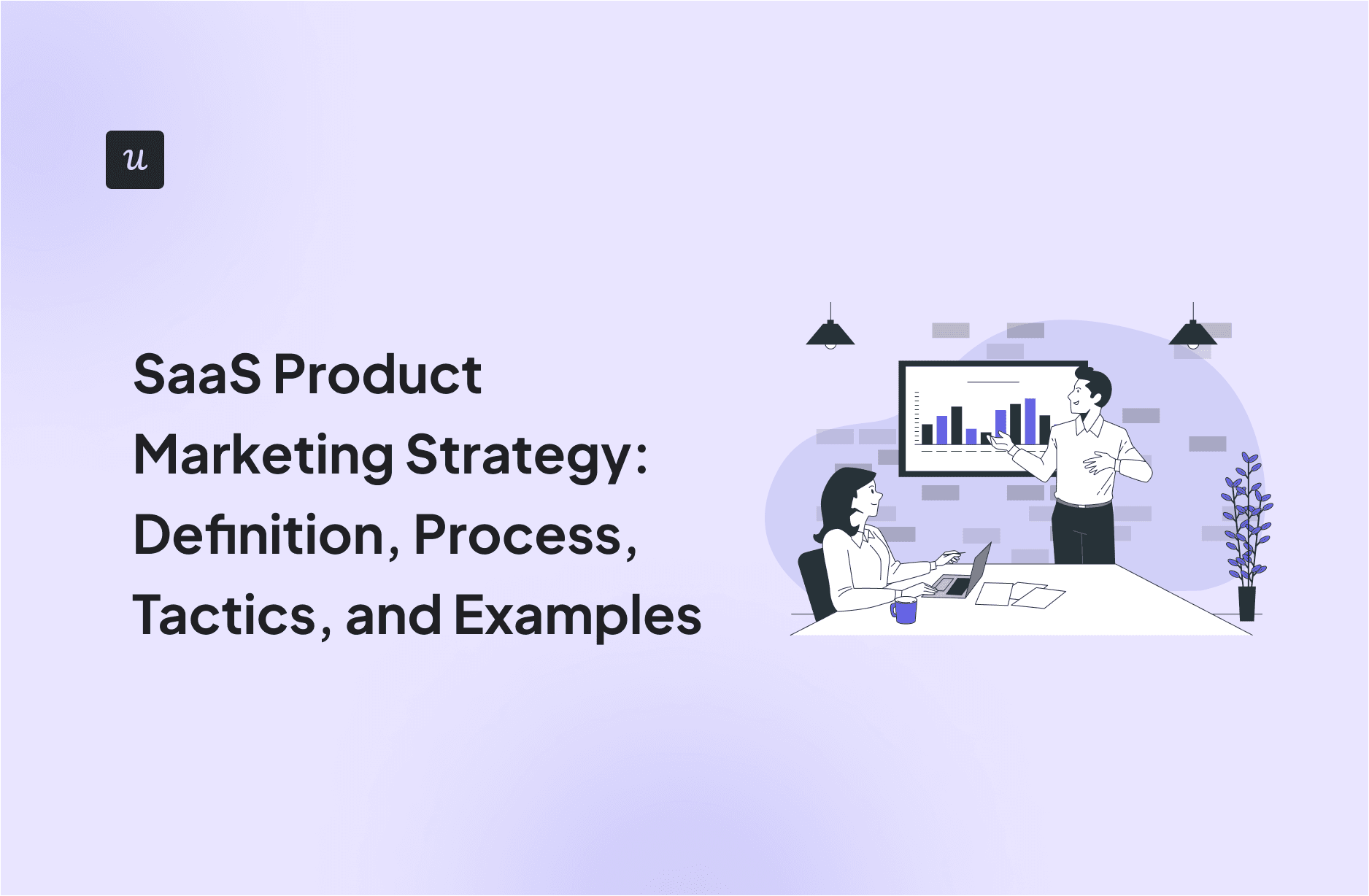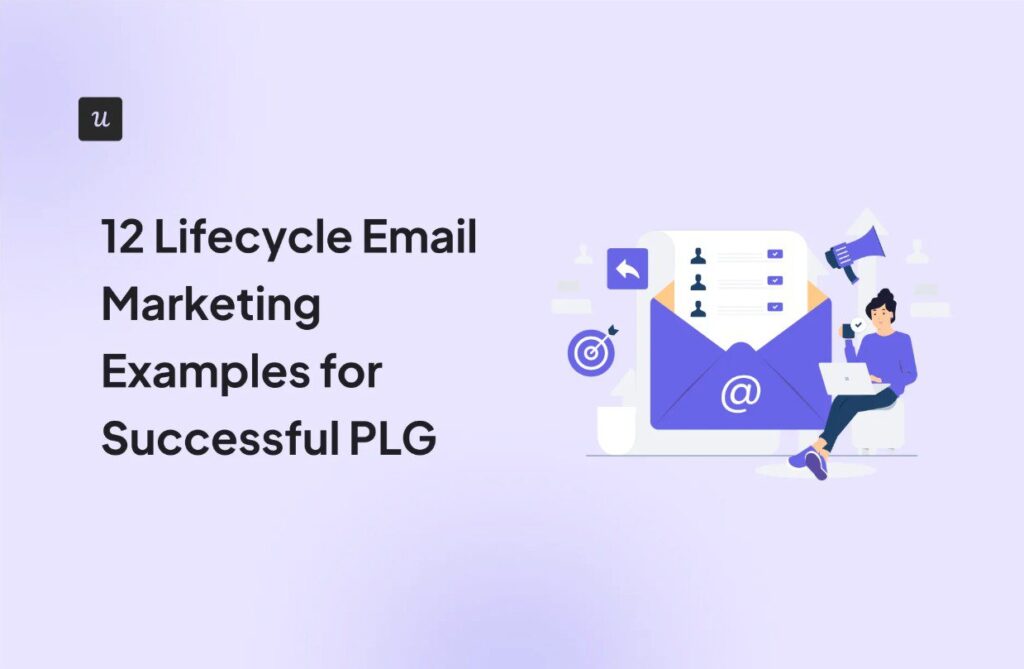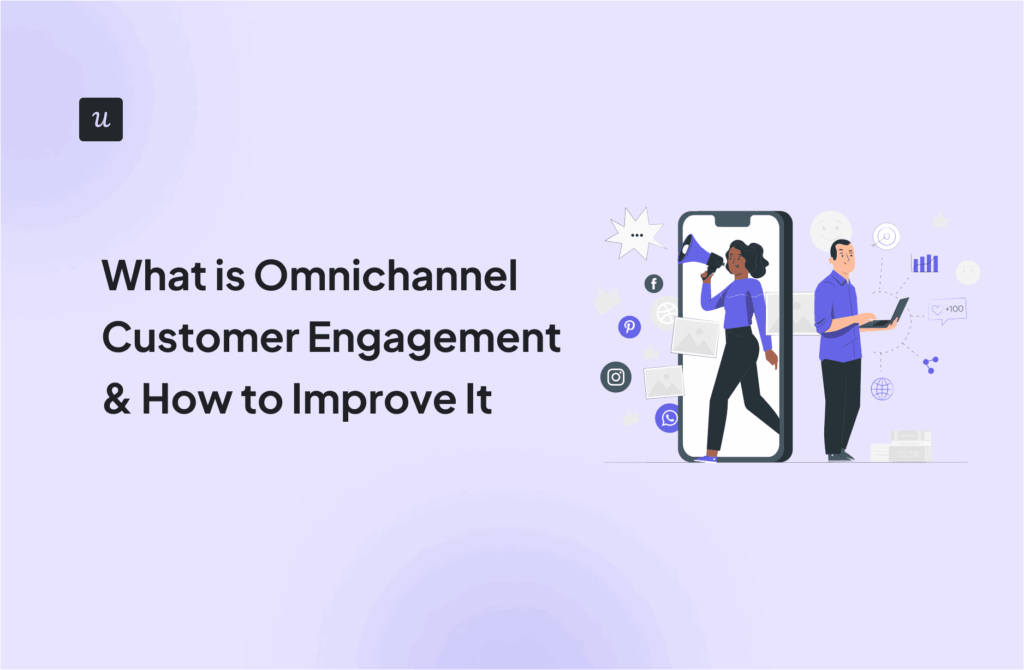
SaaS Product Marketing Strategy: Definition, Process, Tactics, and Examples
Get The Insights!
The fastest way to learn about Product Growth, Management & Trends.
What is a SaaS product marketing strategy?
A SaaS product marketing strategy is a detailed plan for effectively promoting and selling software as a service (SaaS) products.
This strategy involves understanding your target audience, creating engaging content, and using various channels to reach potential users. Focusing on your SaaS products‘ unique features and benefits can help you attract and retain users more effectively, regardless of your chosen channel.
SaaS product marketing vs. product management
SaaS product marketing and product management are two distinct yet interconnected roles.
Product management focuses on building the right SaaS products. It focuses on product usability and functionality, ensuring the product meets user needs and works as intended.
On the other hand, SaaS product marketing is about bringing that product into the right hands. This role emphasizes making the product desirable to potential users through strategic promotion and communication.
Here’s how Aatir Abdul Rauf, VP of marketing at vFairs, compares the responsibilities of product managers and product marketing managers.

How to create an effective SaaS marketing plan?
Creating an effective SaaS marketing plan is essential for the success of your software product. Here’s a step-by-step guide to help you develop a full SaaS product marketing strategy that attracts and retains customers.
Define goals to guide your SaaS marketing efforts
Setting clear goals is crucial for guiding your SaaS marketing plan.
Start by setting SMART goals, which are Specific, Measurable, Achievable, Relevant, and Time-bound. For example, a SMART goal for SaaS product marketing could be increasing trial sign-ups by 20% over the next three months.
Prioritize goals that align with your business objectives to ensure that your SaaS marketing efforts contribute to overall success.
Communicate these goals clearly across your product marketing team to ensure everyone is aligned and accountable. Effective goal setting helps your team focus and work towards common product goals.

Understand your target audience thoroughly
Understanding your target audience is vital for effective SaaS product marketing. Conduct detailed market research to identify customer pain points, preferences, and buying behaviors.
This market research can be done through surveys, interviews, and user behavior monitoring tools.
Based on your research, create buyer personas representing different segments of your target audience. These personas will help you tailor your marketing efforts to meet each group’s specific needs and preferences – ensuring your messages resonate and drive engagement.

Choose the most effective channels to market your SaaS business
To market your SaaS business effectively, evaluate the performance and suitability of channels such as content marketing, paid marketing, SEO, and social media marketing.
Assess which channels are most effective for reaching your target audience and achieving your marketing goals. For example, content marketing might be excellent for building trust and educating potential customers, while paid marketing can quickly boost visibility and drive immediate traffic.
Allocate your resources based on each channel’s effectiveness and ROI. This ensures you invest in the channels that deliver the best customer acquisition and growth results.
Understanding your best customer acquisition channels will help you optimize your marketing budget and maximize your return on investment.
Create impactful SaaS marketing campaigns
Creating impactful SaaS marketing campaigns involves developing strategies highlighting your product’s unique value proposition and benefits to your target audience.
Effective campaigns can take various forms, including content marketing, social media ads, email marketing campaigns, and product launches.
For instance, you can create educational content that addresses your audience’s pain points, as discussed in various case studies. Another example is launching your product on Product Hunt to gain immediate visibility and user feedback.
In the image below, Userpilot demonstrates a successful product launch campaign on Product Hunt. They highlight their product’s features, engage with the community, and gather user feedback to improve their offering.

Analyze the performance of your SaaS marketing strategy
Use analytics tools to track key metrics to understand how well your SaaS marketing strategy is working. These include conversion rates, customer acquisition cost (CAC), engagement rates, and customer lifetime value (CLTV). Monitoring these SaaS metrics helps you see what’s working and what needs improvement.
Review and analyze the data regularly to identify trends and insights. This can show you areas where your strategy might need adjustments. An analytics dashboard can make it easier to track important metrics over time.
Additionally, trend analysis can help you spot emerging patterns and make informed decisions to enhance your marketing efforts.

Iterate and refine your product marketing strategy continuously
Continuously improving your product marketing strategy is essential for staying competitive. Gather feedback from customers and internal stakeholders to identify strengths and areas for improvement.
Conduct A/B testing to experiment with different approaches and see what works best. This method allows you to compare two versions of a marketing element, such as a landing page or email campaign, to determine which performs better.
Learn more about effective A/B testing to refine your strategy and drive better results. Continuously iterating and refining ensures that your product marketing strategy remains effective and responsive to changing market conditions.

14 best SaaS marketing strategies to implement
Implementing the right marketing strategies can make a significant difference in the success of your B2B SaaS marketing campaigns. Here are 14 of the best SaaS marketing strategies you can implement to boost your growth and reach your target audience effectively.
1. Create product-led content to attract potential customers
Developing product-led content is a powerful way to attract potential customers. Focus on creating blog posts, eBooks, and guides that highlight how your product solves specific customer pain points. Use SEO best practices to optimize your content for search engines, ensuring it reaches a wider audience.
Focusing on product-led content marketing can effectively demonstrate the value of your product and build trust with your audience. This approach aligns with your overall product marketing strategy, helping to drive traffic and convert leads into loyal customers.

2. Run paid ads to reach target customers
Running paid ads is an effective way to reach your target customers. Set up targeted PPC campaigns on platforms like Google Ads and LinkedIn to connect with potential customers based on specific demographics and interests.
Regularly monitor and adjust your ad campaigns to ensure they perform well and reach the right audience.
By analyzing customer data, you can refine your targeting and improve the effectiveness of your ads, maximizing your return on investment and driving more qualified leads to your SaaS product.
3. Leverage referral programs to attract prospective customers
Creating a referral marketing program is a great way to attract new customers by leveraging your existing customers. Offer incentives, such as discounts or credits, to current customers who refer new users.
This encourages your customers to spread the word about your product and creates a powerful engagement loop that continuously brings in new prospects.
4. Create growth loops for your SaaS products
Designing growth loops involves creating features that encourage users to invite others to use your product. These features can include collaboration tools or social sharing options. They help reduce your customer acquisition costs and expand your customer base.
An example is Calendly’s meeting scheduling feature, which allows users to invite others to schedule appointments. When recipients receive an invite, they interact with Calendly’s interface, which can lead to new sign-ups and increased user adoption.
This process creates a self-sustaining growth loop, continuously bringing in new users without additional marketing efforts. Leveraging growth loops can lower your customer acquisition cost and achieve scalable growth.

5. Provide free trials to showcase product value
Offering a limited-time free trial is an effective way to showcase your product’s value to potential customers. By giving users full or limited access to your product’s premium features, you demonstrate your value proposition and make it easier for them to decide whether to purchase.
Free trials allow users to experience the benefits of your product firsthand, increasing the likelihood of conversion.
6. Make the sign-up process frictionless
Simplify the sign-up process to make it easy for potential customers to start using your product. Reduce the required fields and consider adding Single Sign-On (SSO) options. This will minimize barriers and create a frictionless customer experience, encouraging more users to complete the sign-up flow.
A streamlined sign-up process can significantly increase your conversion rates by making it quick and easy for users to get started with your product.
7. Use video marketing to onboard users effectively
Creating onboarding videos is an excellent way to demonstrate how to use your product and highlight its key features. Share these videos within your app, through email campaigns, and in your resource center to ensure more users see them.
This approach helps new users quickly understand how to get the most out of your product, improving their overall customer experience.

8. Announce new features in-app to existing customers
Use in-app messages to inform your users about new features and updates. This approach engages your users and keeps them retained.
Regular communication about enhancements shows that you continuously improve the product, adding value for your customers.
Effective new feature announcements can support account expansion by highlighting the benefits of advanced features, prompting users to consider higher-tier plans.
9. Use email marketing to reengage inactive users
Segment your email list to identify inactive users and send personalized re-engagement campaigns. Offer incentives such as discounts or exclusive content to encourage these users to return to your product.
By targeting inactive users with tailored messages, you can reignite their interest and bring them back into active use. Effective strategies to reengage inactive users through email marketing can help boost your retention rates and maintain a strong, active user base.
10. Reward loyal customers to increase customer retention
Implement a loyalty program that rewards customers for their continued use and advocacy of your product. To show your appreciation for their loyalty, offer exclusive perks, discounts, or early access to new features.
This makes your customers feel valued and encourages them to remain engaged with your product over the long term.
By focusing on customer loyalty and retention, you can create a strong, dedicated user base that contributes to the sustained success of your SaaS product.

11. Create impactful customer success stories
Collect and document customer success stories highlighting the benefits and results of using your product. Share these stories on your website, social media platforms, and sales demo calls to build credibility and trust.
Showcasing real-world examples of how your product has helped customers can boost customer confidence.
Effective case studies serve as powerful testimonials demonstrating your product’s value and reliability, helping attract and convert new customers.
12. Promote community-led growth
Build and nurture an online community where users can share tips, ask questions, and provide feedback. Engage regularly with the community through discussions, Q&A sessions, and exclusive content to foster a sense of belonging.
A strong community can drive community-led growth by encouraging user interaction and advocacy. This approach helps users get more value from your product and builds loyalty and retention.
13. Partner with other companies to reach a wider target market
Identify complementary SaaS businesses and create co-marketing campaigns, such as joint webinars or content collaborations between marketing teams. These partnerships can help you reach a wider target market by leveraging each other’s audiences.
You can also offer integrations with other tools to make your product easier to use. This enhances your product’s functionality and attracts users who are already using these complementary tools, increasing your potential customer base.
14. Conduct webinars to engage users
Host webinars that provide valuable insights, product demonstrations, and educational content to engage your users. Webinars are an excellent way to connect with your audience, answer their questions in real time, and showcase the value of your product.
Leveraging webinars for customer education helps build a knowledgeable user base, increase engagement, and strengthen customer relationships.

Product marketing examples from successful SaaS companies
Learning from the best can inspire and guide your own B2B SaaS marketing. Here are some standout product marketing examples from successful SaaS companies that have effectively captured their target audiences and driven growth.
Dropbox
Dropbox implemented a highly successful referral program that incentivized users to invite their friends to join the platform.
As seen in the image, Dropbox offers up to 32 GB of free space for users who invite friends to sign up and install Dropbox. For each friend who joins, the user receives 1 GB, and the friend receives 500 MB of bonus space.
This referral program significantly contributed to Dropbox’s product virality. By rewarding users with additional storage, Dropbox encouraged its existing user base to actively promote the service actively, leading to exponential growth.

Userpilot
The sign-up page example from Userpilot is simple and user-friendly, minimizing friction for new users. It includes essential fields and offers Single Sign-On (SSO) options for a smoother registration process.
This approach aligns with best practices for sign-up page design, ensuring new users can easily get started with the product.
It also includes a customer testimonial to build trust and demonstrate the product’s value.

Loom
Loom uses an effective customer onboarding strategy that involves video tutorials to help new users get started quickly and efficiently.
As shown in the image, Loom provides short, engaging videos covering different aspects of using their product, such as introductions, replacing meetings with Loom, giving feedback, and recording presentations.
These videos are easily accessible from the home screen, ensuring new users can find them immediately. This approach helps users quickly understand the product’s features and benefits, reducing the learning curve and enhancing user satisfaction.

Grammarly
Grammarly uses personalized email marketing to reengage inactive users and return them to the platform. The image shows an example of an email sent to a user who had previously installed Grammarly but stopped using it. The email includes a friendly reminder and a reward—a “Wrinkle in Time Badge”—to entice the user to return.
This approach leverages contextual email marketing by tailoring the message to the user’s past behavior and offering a personalized incentive. The call-to-action button (“GO!”) is prominently displayed, encouraging immediate interaction.

Notion
Notion leverages customer success stories to highlight the versatility and effectiveness of its product. The image showcases various case studies of different SaaS companies using Notion to solve their unique challenges.
For example, Mangopay uses Notion to organize company knowledge and boost employee engagement. Lyka uses Notion to streamline marketing team collaboration and save costs, while Formo improves business agility and TheFork enhances organization.
By presenting these diverse success stories, Notion demonstrates how their product can be adapted to various business needs and industries. This approach builds credibility and inspires potential customers by showing real-world applications and tangible benefits.

Conclusion
SaaS marketing strategies are essential to planning and executing your product marketing campaign. Without them, you cannot create a splash when launching new features and trying to create a buzz about your product.
If you need some help with your B2B SaaS marketing, then Userpilot can help. It can help you with detailed analytics so you know what’s working and isn’t and conduct A/B testing to experiment with new marketing strategies. If you want to learn more, book a demo now.






